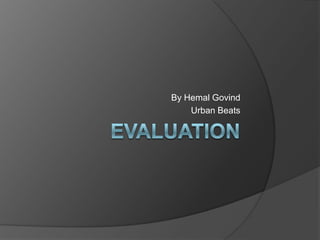My evaluation urban beats
- 1. EvaluationBy Hemal GovindUrban Beats
- 2. In what ways does your media product use, develop or challenge forms and conventions of real media products?My media product, a music magazine, represents many conventions of real media products such as layout, layering, aligning text, appropriate language, ratio of advertisements to content, copy to pictures, price, and target audience.The layout I used for my front cover is a typical magazine front cover. I layered the medium shot of an upcoming artist to be in front of the masthead and behind the sub-headings similarly to VIBE magazine. I have aligned most of my headings to the right so when the magazine is stacked on the shelf, you can see the headings which will attract customers. Rather than magazines like Mojo, I have recognised that shops no longer stack magazines next to each other and now shelf them as bins therefore instead of using the conventional layout I have developed it. Many magazines have a freebie like VIBE and The Source, I have a free CD available when a customer purchases a copy, thus attracting them to buy the magazine. My front cover has the same background and layout to my double page spread which shows consistency. I did this because my front cover is a taster of my double page feature attracting the customer to read the double page feature. In my double page I used appropriate language to suit my target audience and used less sophisticated words and the upcoming artist uses slang which I have not edited so my audience will feel this is more targeted towards them. Like a conventional media product, I have used advertisement to raise finance and therefore lower the cost of my magazine. About 20% of my magazine is advertisements which is like a typical magazine. I have used more pictures to the amount of copy as my audience are from 14-24 which like reading less and like more visual content.
- 3. How does your media product represent particular social groups?My media product, a music magazine, focuses more on the working class social group rather than middle and upper-class as the genre of music my magazine is based on is hip hop which is popular amongst the working class. My music magazine, Urban Beats, is targeted more to people living around тАЬUrbanтАЭ areas hence the title Urban Beats therefore teenagers and young adults will be more interested. Ages ranging from 14 тАУ 24 is the target audience I predict as the artists are 18 and relate to teenagers and young adults as they have grown up similarly.
- 4. What kind of media institution might distribute your media product and why?When researching, the media institutions that I think are best to distribute my product are either IPC Media or Bauer Media, This is because they have a wide range of cross media ownership meaning that my product can be advertised widely through other media. Also because they are Horizontally integrated I can take advantage of this and use cross media promotion to maximise awareness and sales. So this means I can use Mediums such as radio, television and internet to promote my magazine. Like NME they use cross media ownership and take advantage of this, distributed by IPC, which is a reason for its success.
- 5. Who would be the audience for your mediaproduct?The audience for my product would range from 14-24 as they are teenagers/young adults and have the same age group as my product. Its not a big age range so then my product relates to a lot of people but its not too small as well so it doesn't target to a niche market . The audience of my product will be more working class than middle class as my product is more тАЬUrbanтАЭ than anything. Therefore people with the same social background will be more interested in this product because they can relate to it, rather than the middle class citizens who wouldnтАЩt like the product.
- 6. How did you attract/address your audience?I attracted my audience in different ways. Such as giving away a free CD. This will interest my audience as they think they are getting something out of the magazine other than reading it and getting more for there money. Also it will differentiate my product from others. Also my magazine will attract my audience as it is seasonal and tells the audience about artist resolutions which my audience may be interested in as they might be thinking of their own resolutions.
- 7. What have you learnt about technologies from the process of constructing this product?I have learnt many skills when constructing my product. Most of my product is constructed on Adobe photoshop, which I had no skills in. Throughout my product my skills adapted and I learnt skills that helped me make my product what it is. I have also learnt how to take different camera shots which have different meanings. So taking the right shot from the right angle means a lot. Using a camera with different lighting are skills I have learnt during this product.
- 8. Looking back at your preliminary task, what do you feel you have learnt in the progression from it to the full product?I have learnt many skills to further develop my product. Like taking the right picture form the right angle and with the right lighting is a major issue , as when I took a picture with my preliminary task I didnтАЩt really think I had to look so much into the perfect shot. Also using different software and playing around with it helped me further progress from my preliminary to my final.








